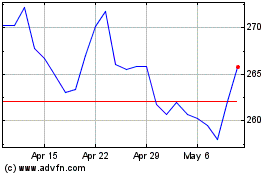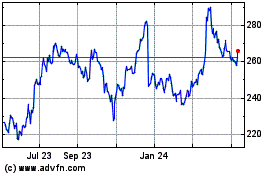By Paul Ziobro
United Parcel Service Inc. wants to get paid for packages it
never delivers.
The company is starting to ask major retailers to help pay for
extra workers and surplus space on trucks when a retailer fails to
ship as many packages as planned during peak periods, UPS
executives say.
The new charges could also apply if a retailer's forecast veers
off course in other ways, such as if the sizes of boxes shipped are
significantly mismatched from what was expected.
"If there are variations to the plan, let's see what we can do,
but we should be compensated accordingly," said UPS Chief Executive
David Abney in an interview. He said the charge isn't meant to be
punitive but one element of a broader negotiation with retailers
over pricing during peak times.
UPS, like rival FedEx Corp., is grappling with the e-commerce
boom, which is resulting in more business but rising costs to pick
up, sort and deliver packages. The difficulties increase during the
peak holiday season, when a greater percentage of deliveries are to
homes and apartment buildings, which cost more for UPS to fulfill
than to business addresses.
Both companies are looking for ways to recoup the billions they
are investing to add capacity to their networks to handle the surge
in online shopping. FedEx says it has dropped some retailers that
refused recent price increases, and UPS has raised prices and
invested in new routing systems and bigger storage facilities.
It faces skepticism, however, that it isn't raising retailer
prices as aggressively as FedEx. Mr. Abney has previously said that
UPS could lose business if it doesn't make such changes carefully,
adding "You do that and at some point, you can have unused
capacity."
FedEx doesn't plan to charge retail customers that fall short on
promised package volumes, said its senior vice president for
e-commerce Carl Asmus. "The last thing I'd ever want to do or say
is I'm going to penalize a customer."
Like UPS, FedEx sets prices for large customers on a
case-by-case basis, with delivery rates varying based on the volume
of packages and where they need to be shipped, among other factors.
With its biggest retailer customers, the company starts the process
of planning for the holiday rush in June, Mr. Asmus said.
FedEx might adjust pricing lower for companies that ship larger
volumes but wouldn't charge them for failing to meet their
projections.
Delivery companies typically have multiyear contracts with top
retailers laying out rates, discounts and other elements about how
much it will cost to ship packages. But they still start up
conversations around midyear to share data and perform an autopsy
of the past holiday season and discuss how strategies and
investments should change for the next peak period.
Retailers, for their part, have their own challenges. Online
sales are coming at the expense of their brick-and-mortar
operations in many cases, forcing them to close stores and cut
costs wherever they can, and some of them lag behind newer players
when it comes to e-commerce.
Retailers with physical locations are increasingly using them as
places for customers to pick up online orders. Wal-Mart Stores
Inc., for example, last month began offering discounts to customers
who place orders for online-only merchandise and pick them up at
stores.
Those efforts could potentially lower some of the package volume
headed to residences if it is directed to stores instead -- "which
is great business for us," said Alan Gershenhorn, UPS's chief
commercial officer, during a conference call with analysts last
month.
UPS cautioned that conversations with retailers are just
starting and it is still working to complete how the surge price
will be implemented. "We will handle it on a customer by customer
basis, we will look at our costs and that's the way we're going to
address it," Mr. Abney said.
As it is for retailers, the peak season is a critical stretch
for UPS and FedEx. Last year, UPS said that daily delivery volume
on 13 days in December swelled to 30 million packages, compared
with 18 million on a normal nonpeak day.
Typically, the brunt of the surge comes from just a few dozen
e-commerce retailers. FedEx Chief Executive Fred Smith has said no
more that 50 customers are behind the bulk of the increase.
UPS is focusing the surcharge on the top shippers by volume
during the winter holidays. The company will also seek to apply it
to other events that cause volumes to swell, such as flower
shipments during Valentine's and Mother's Day, and when new
gadgets, videogames and books are released.
The extra business has posed a major challenge for the delivery
companies. Investors are worried that the capital investments to
keep up with the growth aren't paying off quickly enough,
especially during holidays.
"We believe that should be the company's highest margin quarter,
given the HR and logistics gymnastics UPS performs to execute for a
handful of e-commerce shippers," Stifel Nicolaus & Co. analyst
David Ross said in a research note.
One challenge has been that forecasting sales has become
increasingly challenging as shopping shifts online, oftentimes to
competitors such as Amazon.com Inc. Many traditional chains,
including Macy's Inc. and Toys "R" Us Inc., struggled to predict
their holiday sales last year.
"The problem for the shipper is that nobody is able to
accurately forecast e-commerce because things are changing so
rapidly," said John Haber, CEO of supply-chain consultancy Spend
Management Experts.
In 2015, UPS started imposing additional charges on shipments
when retailers blew through their shipping estimates, driving up
costs. But now, UPS is looking for protection on the downside
too.
FedEx ran into such trouble this past holiday season. In March,
the company said some of its largest retail customers that use its
ground-shipping business fell short of their forecasts. That left
FedEx confronting a burden from spending the company put toward
extra staffing and trucks. Operating margins for FedEx's ground
segment declined from 12.6% to 11% in the quarter ended Feb.
28.
During March's earnings call, FedEx Chief Marketing Officer
Rajesh Subramaniam said the company is "looking at several pricing
options to ensure that we get a reasonable return on investments
that we are making."
--Brian Baskin contributed to this article.
Write to Paul Ziobro at Paul.Ziobro@wsj.com
(END) Dow Jones Newswires
May 01, 2017 16:55 ET (20:55 GMT)
Copyright (c) 2017 Dow Jones & Company, Inc.
FedEx (NYSE:FDX)
Historical Stock Chart
From Mar 2024 to Apr 2024

FedEx (NYSE:FDX)
Historical Stock Chart
From Apr 2023 to Apr 2024
